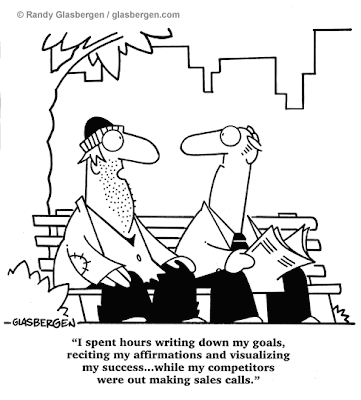Right about now, all salespeople on a calendar fiscal year are thinking one of three things:
1) "I am kicking ass and am either at or above my 6-month target/quota!"
2) "I am in it deep. If I don't get my crap together soon, there's no way in hell I'm going to hit my goal!"
3) "What are you talking about? What month is it?"
Actually, #1 or #2 are good things for you to be thinking. The third one, however, is a real problem - and worst part about it, is that if you can't make a mental-shift to 1 or 2, you're in for a world of hurt. Let's talk about five important things all salespeople should be doing at the half-way point in the year:
- Did you plan your success (or failure) over the past 6 months? Successful people (in any profession or with any goal), plan for their success. They know what things needs to be done to achieve a specific result. OK, I know I'm over-simplifying the complex reality of selling in the real world; however, I will argue with anyone, that if you evaluate your sales activity, pipeline, closing ratios and bookings, you should be able to modify your behavior and adjust accordingly.
- Mid-Year is NOTHING! Salespeople can push half a year's worth of work into 6-months. Don't freak out. Even if you've sold $0 so far this year, you can still kill it. This is a mental game and you control your own destiny. Today is the day for you to get more organized, become more efficient, be more productive, and change everything.
- Every step in the right direction moves you closer to goal. Do you have a $1M target? Book that $5K deal and be loud and proud. Sales is a funny little business. When you book nothing, it gets you down. When you book anything (even a small dollar amount), things look brighter and cheerier. Get a deal, any deal and use that momentum to spiral you forward.
- You need to work harder. Sheer perspiration and perseverance goes a long way in sales. If you haven't figured out the subtle nature of increased efficiency, tools and how to work smarter, it's time to simply ramp it up! There's way more than eight hours in a day. Get your ass up at 6AM, plan your day, and work until 10PM at night. Do whatever you need to do.
- It's not too late! It's almost never too late (with some exceptions - if you've blown it for a year, it's unlikely your company will "restart" the engine with you). If it's not too late for you - get it together. Most companies will be patient as long as they see appointments, pipeline growth and (eventually) some bookings.
Let's get busy. It's only July. Happy Selling.





